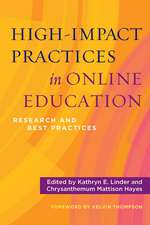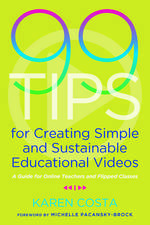Online Teaching at Its Best – Merging Instructional Design with Teaching and Learning Research, Second Edition
Autor LB Nilsonen Limba Engleză Paperback – 11 iul 2021
Preț: 241.61 lei
Nou
Puncte Express: 362
Preț estimativ în valută:
46.23€ • 48.27$ • 38.26£
46.23€ • 48.27$ • 38.26£
Carte disponibilă
Livrare economică 14-28 martie
Livrare express 28 februarie-06 martie pentru 45.93 lei
Preluare comenzi: 021 569.72.76
Specificații
ISBN-13: 9781119765011
ISBN-10: 1119765013
Pagini: 304
Dimensiuni: 215 x 283 x 17 mm
Greutate: 0.7 kg
Ediția:2nd Edition
Editura: JOSSEY BASS
Locul publicării:Hoboken, United States
ISBN-10: 1119765013
Pagini: 304
Dimensiuni: 215 x 283 x 17 mm
Greutate: 0.7 kg
Ediția:2nd Edition
Editura: JOSSEY BASS
Locul publicării:Hoboken, United States
Notă biografică
LINDA B. NILSON, PHD, is Director Emerita of the Office of Teaching Effectiveness and Innovation at Clemson University. She is a sought-after speaker, workshop leader, and consultant and has authored several books, including Teaching at Its Best, Creating Engaging Discussions, Specifications Grading: Restoring Rigor, Motivating Students, and Saving Faculty Time, Creating Self-Regulated Learners, and Infusing Critical Thinking into Your Course.
LUDWIKA A. GOODSON, BS, MA, is an education consultant with over 20 years experience in higher education. She has been president of Instructional Systems Design, an evaluator for faculty development projects, and an expert consultant for the Association for College and University Educators.
Cuprins
The Authors xi
Preface xiii
1 Teaching at Its Best, No Matter What the Environment 1
teaching Quality as Key to Learning 1
the Many Modes of teaching today 8
the special Challenges of online Learning 13
Interweaving two Unconnected Literatures 14
Reflections 17
2 Setting Significant Outcomes 25
Why students need What We teach 25
How Content Becomes the Wrong Driver 26
Leading students to a Meaningful Destination 27
examples of significant Learning from Instructional Design 28
examples of significant Learning from College Courses 29
examples of significant Learning from Adaptive Learning 32
the Process of Reflection 32
Reflections 34
3 Designing a Coherent Course 41
online Course Design standards 41
Phases of Course Design 43
organizing for Your students' needs 45
Course Design templates and Maps 47
Writing and sequencing Learning outcomes 51
Developing Valid Assessments 54
Mapping Learning Activities to outcomes 65
Choosing online and offline Course Content 69
Online Copyright Guidelines 72
The Syllabus: What to Include 74
Organizing Your Files for Yourself and Your Students 77
Reflections 78
4 Applying Cognitive Science to Online Teaching and Learning Strategies 91
Twenty-Five Principles of Learning from Cognitive Science 91
How These Principles Can Inform Online Course Design and Teaching 94
Reflections 107
5 Motivating Elements 115
Motivating Student Effort and Achievement 115
Creating Too Much of a Good Thing? 117
Leveraging Intrinsic and Extrinsic Motivators 117
Reinforcing and Punishing 118
Gaining and Maintaining Attention 119
Ensuring Relevance 120
Encouraging Goal Expectancy and Self-Efficacy 123
Creating Satisfaction 127
Fostering Social Belonging 129
Motivating as Our Major Task 129
Reflections 130
6 Developing Interactivity, Social Connections, and Community 139
Effects of Interactions on Learning 139
Student-Instructor Interaction 141
Student-Content Interaction 145
Student-Student Interaction 163
Interactions with Technology 169
Reflections 171
7 Making Accessibility for Everyone Much Easier 181
Why Use Student-Centered Design? 181
Sources of Obstacles 183
Overcoming Obstacles 183
Guidelines and Standards for Designing Accessibility 185
Specific How-To's of Ensuring Accessibility 187
Additional Resources and Advice 201
Reflections 203
8 Creating a Supportive Culture for Online, Remote, and Hyflex Teaching 209
The Importance of Quality in Online, Remote, and Hyflex Courses 209
Faculty Challenges in Remote and Hyflex Teaching 213
Faculty Challenges in Transitioning to Online Teaching 215
Faculty Support for Remote and Hyflex Teaching 217
Faculty Incentives and Support for Online Teaching 219
Designing Effective Professional Development 224
Models for a Professional Development Program in Online Teaching 229
Conclusion 233
Reflections 234
Appendix A: Online Course Development Checklist 241
Essential Quicksteps 241
Course Beginnings 248
Technology 250
Assessments and Grading 252
Course Materials 254
Student Interactions with the Content, Instructor, and Peers 255
Appendix B: Accessibility Resources 257
Strategies to Make Access to Course Materials Easy 257
Ways to Make Accessible Document Files 259
Ways to Design Accessible PowerPoint Presentations 262
Captioning Resources 262
Accessibility Checks 263
Resources for Students 263
Index 267












